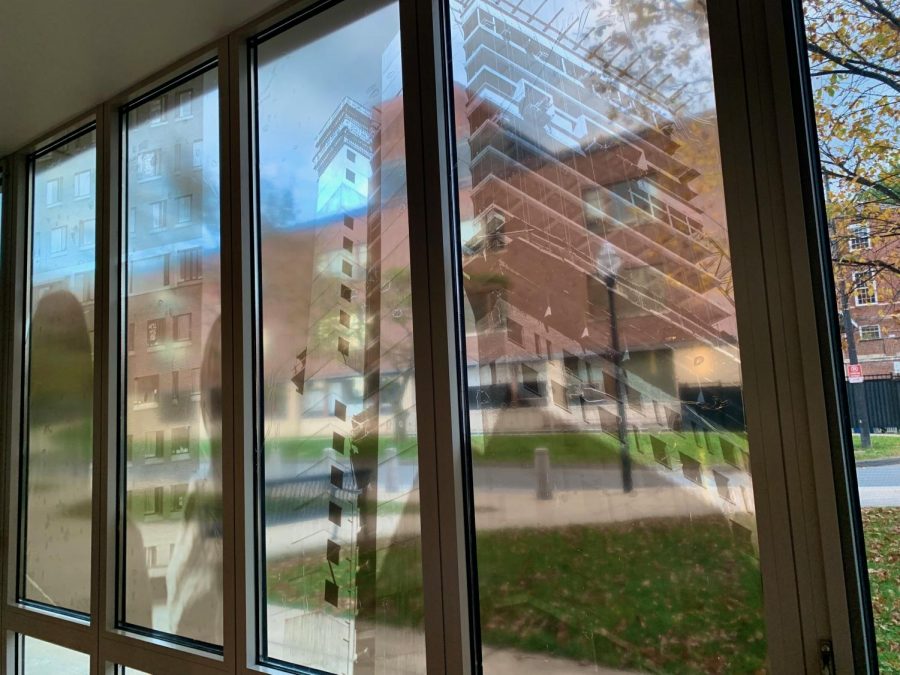The University of Massachusetts is embracing its Brutalist architecture with a two-day symposium and on-campus art exhibits this semester.
The Whitmore Administration Building, Randolph W. Bromery Center for the Arts, Campus Center, Herter and Tobin Halls, W.E.B. Du Bois Library and Southwest Residential Area feature the Brutalist style, famous for its rough, geometric exteriors made from concrete and brick.
The style is controversial around campus, but UMass art history and architecture professor Dr. Timothy Rohan said students should reconsider calling the buildings “ugly.”
“Scholars have shown that ‘ugly’ is used most often by people when they want to degenerate something that they find different,” Rohan said.
UMass graduate researcher Dr. Lincoln Nemetz-Carlson sees artistry in the buildings.
“They are sculptures, and they’re avant-garde, and they’re strange, and they don’t look like anything else. I like the fact that they’re living pieces of art,” Nemetz-Carlson said.
The Brutalism @ UMass symposium aimed to celebrate the style by bringing together architects, scholars and conservators from across the country. The two-day event took place at UMass Dartmouth on Oct. 22 and UMass Amherst on Oct. 23. Speakers discussed concrete conservation, technical challenges and the future of Brutalism.
The prevalence of Brutalism at UMass Amherst and Dartmouth is unusual for public universities. Rohan calls UMass Dartmouth a “single-vision campus,” a place built at one time and under one person’s vision. Architect Paul Rudolph designed the campus to be cohesive, which is rarely true of other universities.
In the 1960s, the functionality of Brutalism allowed UMass Amherst to educate a rapidly growing student body. Southwest Residential Area, built in 1964, houses 5,500 students and remains the largest residential area on campus. The Center for the Arts, which opened in 1975, was designed as a “gateway to the campus.” Architect Kevin Roche intended for the building to have an open view from Haigis Mall to the campus pond, without the glass lobby in place today. The two reflecting pools in front of the original FAC building were filled in during the early 2000s.
Rohan said maintenance of existing Brutalist buildings, rather than replacement, is environmentally friendly and would change students’ minds about the style.
“The most sustainable thing you can do is preserve, rather than destroy,” Rohan said.
Two exhibits on campus aim to inform students about the history and artistry of brutalism. “Brutalism in Color,” located in the lobby of the Center for the Arts until Oct. 31, highlights the style’s original use of textiles and art.
“My idea behind the exhibit was to show off another side of brutalism,” Nemetz-Carlson said. “Truth is that these buildings were originally built with a very colorful context.”
“Standing in Silhouette: The Southwest Dormitories at UMass,” located in the Greenbaum Gallery until Dec. 8, highlights photographs of students in Southwest through the years. One photo, likely taken in the 1960s, features an unknown woman standing with her hands on her hips in front of a Southwest tower. Rohan hopes an article in UMass Magazine will reveal her identity and offer a story about the photo’s origins. A similar photo of Callie Krekorian, Rohan’s former student, wearing a mask and standing in the same position is a visual display of how times have changed.
Rohan and Nemetz-Carlson are hopeful about the influence of Brutalism at UMass.
“People all over the country and all over the world are coming to look at our buildings,” Nemetz-Carlson said. “I hope that the UMass community can come to appreciate our buildings the way that the rest of the world… see[s] it.”
“If we all feel better about the brutalist buildings at UMass Amherst, we’ll feel better about the University and ourselves. It will create an improved climate in every way,” Rohan said.
Catherine Hurley can be reached at [email protected] and followed on Twitter @cath_hurley.





















KG26 • Oct 29, 2021 at 10:49 pm
As a former student found those architectural features were essentially dehumanizing & ugly.